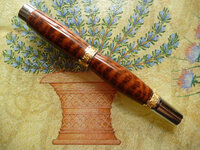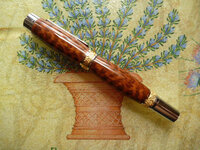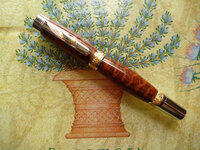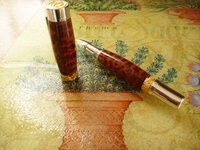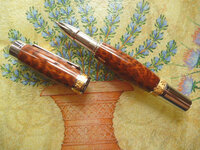Bree
Member
Got a beautiful piece of insanely expensive Snakewood at West Penn. I thought it might go well with an Imperial kit with gold to complement the colors of the Snakewood. Turned it slowly and with very sharp tools. Had no issues. Since it is very cracky wood, I decided to attack the source of most wood cracks... the end grain.
I put a drop of thin CA on some release paper and touched the end of the turned wood/tube to the meniscus of the drop. This causes the CA to literally form a bridge between the drop and the wood. I slowly rolled the tube careful not to break the surface tension bridge. This uniformly distributed CA on the end of the tube and allowed the CA to wick into the end grain. I did this to both tubes, both ends twice.
Then I applied thin CA to the wood followed by a quick rub and a hit of accelerator. I did this about 7 times to build up the volume of the CA coating. I gave it a quick hit with the maroon Micromesh to bring down the ridges and then applied three coats of Medium CA with BLO to fill in any gaps and further raise the coating level. Then I dry micromeshed the wood to 12,000 followed by a light buffing on the White China wheel.
Polished it with Meguiar's Extreme ScratchX and then PlastX. Light coat of Ren Wax and she was ready to assemble. The gold ring on the center coupler was loose so I put a drop of thin CA on a needle and wicked it into the ring and locked it in place. Didn't get on the Rhodium so there was no clean up necessary.
I have attached several shots of the completed pen.
I put a drop of thin CA on some release paper and touched the end of the turned wood/tube to the meniscus of the drop. This causes the CA to literally form a bridge between the drop and the wood. I slowly rolled the tube careful not to break the surface tension bridge. This uniformly distributed CA on the end of the tube and allowed the CA to wick into the end grain. I did this to both tubes, both ends twice.
Then I applied thin CA to the wood followed by a quick rub and a hit of accelerator. I did this about 7 times to build up the volume of the CA coating. I gave it a quick hit with the maroon Micromesh to bring down the ridges and then applied three coats of Medium CA with BLO to fill in any gaps and further raise the coating level. Then I dry micromeshed the wood to 12,000 followed by a light buffing on the White China wheel.
Polished it with Meguiar's Extreme ScratchX and then PlastX. Light coat of Ren Wax and she was ready to assemble. The gold ring on the center coupler was loose so I put a drop of thin CA on a needle and wicked it into the ring and locked it in place. Didn't get on the Rhodium so there was no clean up necessary.
I have attached several shots of the completed pen.

